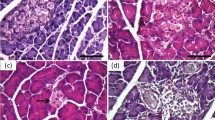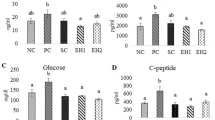Abstract
Diabetes mellitus, with its attendant disorders and dysfunctional behaviors, constitutes a growing concern to the population of the world. With this concern in mind, the present study investigated the anti-diabetic and hypolipedimic potential of 17β-estradiol (called E2), particularly in terms of its inhibitory effects on maltase, sucrase, lactase, and lipase activities in the intestine of surviving diabetic rats. The findings revealed that this supplement helped protect the β cells of the rats from death and damage. Interestingly, E2 induced considerable decreases of 29%, 46%, 42%, and 84% in the activities of intestinal maltase, lactase, sucrase, and lipase, respectively. The E2 extract also decreased the glucose, triglyceride, and total cholesterol rates in the plasma of diabetic rats by 39%, 27%, and 53%, respectively, and increased the HDL–cholesterol level by 74%, which helped maintain the homeostasis of blood lipid. When compared to those of the untreated diabetic rats, the superoxide dismutase, catalase, and glutathione peroxidase levels in the pancreas of the rats treated with this supplement were also enhanced by 330%, 170%, and 301%, respectively. A significant decrease was also observed in the lipid peroxidation level and lactate dehydrogenase activity in the pancreas of diabetic rats after E2 administration. Overall, the findings presented in this study demonstrate that E2 has both a promising potential with regard to the inhibition of intestinal maltase, sucrase, lactase, and lipase activities, and a valuable hypoglycemic and hypolipidemic function, which make it a potential strong candidate for industrial application as apharmacological agent for the treatment and prevention of hyperlipidemia, obesity, and cardiovascular diseases.



Similar content being viewed by others
References
Aebi H (1984) Catalase in vitro. Meth Enzymol 105:121–126
Buege JA, Aust SD (1967) Microsomal lipid peroxidation. Meth Enzymol 105:302–310
Dahlqvist A (1968) Assay of intestinal disaccharidases. Anal Biochem 22:99–107
Fonseca V (2003) Clinical significance of targeting postprandial and fasting hyperglycemia in managing type 2 diabetes mellitus. Curr Med Res Opin 19:635–641
González-Gil EM, Bueno-Lozano G, Bueno-Lozano O, Moreno LA, Cuadrón-Andres L, Huerta-Blas P, Garagorri JM, Bueno M (2009) Serum transaminases concentrations in obese children and adolescents. J Physiol Biochem 65:51–60
Hamden K, Carreau S, Jamoussi K, Ayadi F, Garmazi F, Elfeki A (2008) Inhibitory effects of 1α, 25dihydroxyvitamin D3 and Ajuga iva extract on oxidative stress, toxicity and hypo-fertility in diabetic rat testes. J Physiol Biochem 64:231–240
Hamden K, Carreau S, Lajmi S, Aloulou D, Kchaou D, Elfeki A (2008) Protective effect of 17β-estradiol on hyperglycemia, stress oxidant, liver dysfunction and histological changes induced by alloxan in male rat pancreas and liver. Steroids 94:495–501
Hamden K, Allouche N, Damak M, Elfeki A (2009) Hypoglycemic and antioxidant effects of phenolic extracts and purified hydroxytyrosol from olive mill waste in-vitro and in rats. Chem Biol Interact. doi:10.1016/j.cbi.2009.04.002
Hamden K, Ayadi F, Jamoussi K, Masmoudi H, Elfeki A (2009) Therapeutic effect of phytoecdysteroids rich extract from Ajuga iva on alloxan induced diabetic rats liver, kidney and pancreas. Biofactors 33:1–12
Heo SJ, Hwang JY, Choi JI, Han JS, Kim HJ, Jeon YJ (2009) Diphlorethohydroxycarmalol isolated from Ishige okamurae, brown algae, a potent α-glucosidase and α-amylase inhibitor, alleviates postprandial hyperglycemia in diabetic mice. Eur J Pharmacol. doi:10.1016/j.ejphar.2009.05.017
Khookhor O, Bolin Q, Oshida Y, Sato Y (2007) Effect of Mongolian plants on in vivo insulin action in diabetic rats. Diab Res Clin Pract 75:135–140
Kim KY, Nam KA, Kurihara H, Kim SM (2008) Potent α-glucosidase inhibitors purified from the red alga Grateloupia elliptica. Phytochemistry 69:2820–2825
Kowluru RA, Chan PS (2007) Oxidative stress and diabetic retinopathy. Exp Diab Res. doi:10.1155/2007/43603
Le May C, Chu K, Hu M, Ortega CS, Simpson ER, Korach KS, Tsai MJ, Mauvais-Jarvis F (2006) Estrogens protect pancreatic β-cells from apoptosis and prevent insulin-deficient diabetes mellitus in mice. Proc Natl Acad Sci USA 103:9232–9237
Lee DS, Lee SH (2001) Genistein, a soy isoflavone, is a potent α-glucosidase inhibitor. FEBS Lett 501:84–86
Lowry OH, Rosebrough NJ, Farr AL, Randall RJ (1955) Protein measurement with Folin phenol reagent. J Biol Chem 193:265–275
Marklund S, Marklund G (1975) Involvement of the superoxide anion radical in the autoxidation of pyrogallol and a convenient assay for superoxide dismutase. Eur J Biochem 47:469–474
McCue P, Kwon YI, Shetty K (2005) Anti-diabetic and anti-hypertensive potential of sprouted and solid-state bioprocessed soybean. Asia Pac J Clin Nutr 14:145–152
Mccue P, Kwon YI, Shetty K (2005) Anti-amylase, anti-glucosidase and anti-angiotensin I-converting enzyme potential of selected foods. J Food Biochem 29:278–294
McDougall GJ, Stewart D (2005) The inhibitory effects of berry polyphenols on digestive enzymes. Biofactors 23:189–195
O’Donovan C, Feinle-Bisset J, Horowitz M (2003) Lipase inhibition attenuates the acute inhibitory effects of oral fat on food intake in healthy subjects. Br J Nutr 90:849–855
Pagila DE, Valentine WN (1967) Studies on the quantitative and qualitative characterization of erythrocyte glutathione peroxidase. J Lab Clin Med 70:158–169
Prieto-Hontoria PL, Pérez-Matute P, Fernández-Galilea M, Barber A, Martínez JA, Moreno-Aliaga MJ (2009) Lipoic acid prevents body weight gain induced by a high fat diet in rats: effects on intestinal sugar transport. J Physiol Biochem 65:43–50
Sanclemente T, Marques-Lopes I, Puzo J, García-Otín AL (2009) Role of naturally-occurring plant sterols on intestinal cholesterol absorption and plasmatic levels. J Physiol Biochem 65:87–98
Satouchi K, Hiranou K, Fujino O, Ikoma M, Tanaka T, Kitamura K (1998) Lipoxygenase-1 from soybean seed inhibiting the activity of pancreatic lipase. Biosci Biotechnol Biochem 62:1498–1503
Shirpoor A, Ilkhanizadeh B, Saadatian R, Darvari BS, Behtaj F, Karimipour M, Ghaderi-Pakdel F, Saboori E (2006) Effect of vitamin E on diabetes-induced changes in small intestine and plasma antioxidant capacity in rat. J Physiol Biochem 62:171–178
Singh R, Nagapaul JP, Majumdar S, Chakravarti RN, Dhall GI (1985) Effects of 17 beta-estradiol and progesterone on intestinal digestive and absorptive functions in ovariectomized rats. Biochem Int 101:777–786
Viña J, Borrás C, Gambini J, Sastre J, Pallardo FV (2005) Why females live longer than males? Importance of the upregulation of longevity-associated genes by oestrogenic compounds. FEBS Lett 579:2541–2545
Viña J, Sastre J, Pallardó FV, Gambini J, Borrás C (2008) Modulation of longevity-associated genes by estrogens or phytoestrogens. Biol Chem 389:273–277
Yoshikawa M, Shimoda H, Nishida N, Takada M, Matsuda H (2002) Salacia reticulata and its polyphenolic constituents with lipase inhibitory and lipolytic activities have mild antiobesity effects in rats. J Nutr 132:1819–1824
Zirilli L, Rochira V, Diazzi C, Caffagni G, Carani C (2008) Human models of aromatase deficiency. J Steroid Biochem Mol Biol 109:212–218
Acknowledgments
This research was supported by the Tunisian Ministry of Higher Education and Scientific Research and Technology and the Tunisian Ministry of Public Health. The authors wish to express their sincere gratitude to Prof. Anouar Smaoui from the English department at the Faculty of Science of Sfax for carefully proofreading and polishing the language of the present paper.
Author information
Authors and Affiliations
Corresponding author
Rights and permissions
About this article
Cite this article
Hamden, K., Jaouadi, B., Zaraî, N. et al. Inhibitory effects of estrogens on digestive enzymes, insulin deficiency, and pancreas toxicity in diabetic rats. J Physiol Biochem 67, 121–128 (2011). https://doi.org/10.1007/s13105-010-0056-0
Received:
Accepted:
Published:
Issue Date:
DOI: https://doi.org/10.1007/s13105-010-0056-0




